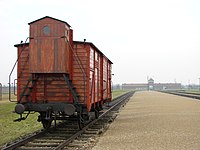Cattle wagon
A cattle wagon is an everyday expression for a railway wagon designed to carry livestock. The American equivalent is called a stock car. A cattle wagon is one type of covered goods wagon, although cattle have also been transported in open goods wagons.[1]
Wagons with special bays or stalls were only used for the transport of racing horses whilst small livestock, such as sheep, goats, poultry and rabbits were transported in livestock wagons with slatted sides and/or hutches. Originally high-sided wagons were also used to move cattle as well as horses and pigs. For the transport of military horses in goods wagons, tethering rings were fitted.[2] The transportation of large and small animals required special fittings – air vents, means of tethering, drinking facilities and viewing ports – in order to avoid quantitative and qualitative losses.[3] Even troops were transported in covered goods wagons.
- Cattle wagons
-
Early example of a cattle wagon preserved on the Severn Valley Railway
-
Cattle wagon Alice Springs
-
Hc Class cattle wagon HC1018 and ganger's hut (on loading bank) at Little River Station. A notable omission are the running boards that should be on top of the roof.
Use for deportation
Given their dimensions and features, cattle wagons have been used as vehicles for forced mass transfer and deportation of people. Holocaust trains were railway transports run by the Deutsche Reichsbahn national railway system under the strict supervision of the German Nazis and their allies, for the purpose of forcible deportation of the Jews, as well as other victims of the Holocaust, to the German Nazi concentration, forced labour, and extermination camps.[4][5]
- Deportation wagons
-
Wagon on Siding near the Auschwitz concentration camp - Oswiecim - Poland.
-
People being deported in cattle wagons cars during World War II
-
A cattle wagon used for the transport of Belgian Jews to camps in Eastern Europe. The openings were covered in barbed wire.[6] This example is preserved at Fort Breendonk.
-
Original wagon used for transport of Macedonian Jews at the Holocaust Memorial Center for the Jews of Macedonia
-
Interior of a covered goods wagon used to transport Jews and other Holocaust victims, the United States Holocaust Memorial Museum in Washington, D.C.
Cattle wagons were used for forced settlement and population transfer in the Soviet Union in the mid-20th century.
Following the end of World War II in Europe, ethnic Germans were expelled from Czechoslovakia in cattle wagons.
See also
References
- ^ Tierbeförderung at Zeno.org. Article by: Viktor von Röll (ed.): Enzyklopädie des Eisenbahnwesens (Encyclopaedia of the Railway), 2nd edition, 1912–1923, Vol. 9, p. 319ff.
- ^ Güterwagen at Zeno.org. Article by: Viktor von Röll (ed.): Enzyklopädie des Eisenbahnwesens (Encyclopaedia of the Railway), 2nd edition, 1912–1923, Vol. 6, p. 19, 26f
- ^ Güterwagen at Zeno.org. Article by: Viktor von Röll (ed.): Enzyklopädie des Eisenbahnwesens (Encyclopaedia of the Railway), 2nd edition, 1912–1923, Vol. 6, p. 28f
- ^ Prof. Ronald J. Berger, University of Wisconsin–Whitewater (2002). Fathoming the Holocaust: A Social Problems Approach. Transaction Publishers. pp. 57–58. ISBN 978-0202366111.
Bureaucrats in the Reichsbahn performed important functions that facilitated the movement of trains. They constructed and published timetables, collected fares, and allocated cars and locomotives. In sending Jews to their death, they did not deviate much from the routine procedures they used to process ordinary train traffic.
- ^ Simone Gigliotti, Victoria University, Australia (2009). The Train Journey: Transit, Captivity, and Witnessing in the Holocaust. Berghahn Books. pp. 36, 55. ISBN 978-1845459277.
{{cite book}}: CS1 maint: multiple names: authors list (link) - ^ Schreiber, Marion (2003). The Twentieth Train: the True Story of the Ambush of the Death Train to Auschwitz (1st US ed.). New York: Grove Press. p. 203. ISBN 978-0-8021-1766-3.






![A cattle wagon used for the transport of Belgian Jews to camps in Eastern Europe. The openings were covered in barbed wire.[6] This example is preserved at Fort Breendonk.](http://upload.wikimedia.org/wikipedia/commons/thumb/f/f1/Breendonk071.jpg/180px-Breendonk071.jpg)

